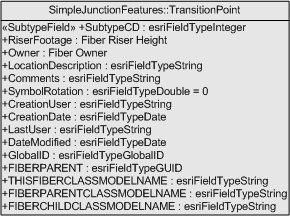

Version: 10.2.1c and 10.2.1.c SP3 |
| Appendix > Fiber Manager Data Model > TransitionPoint |
A TransitionPoint represents a "Fake Splice" in the network. These features can be used anywhere that there is a significant change in the condition of a FiberOpticCable feature that does not occur at a network junction feature. The two examples of a significant change in condition in the data model are a Riser (or PoleDip) and a Demarcation Point. A Riser symbolizes where a cable transitions from an aerial (overhead) installation to a subterranean (underground) installation. A Demarcation Point symbolizes where a cable changes ownership. A change in ownership usually occurs within a splice enclosure or a patch panel, but in some instances may occur at boundaries. For example, the boundary between a university's campus and an adjacent neighborhood or the boundary between government offices and contiguous private businesses. This feature provides a flexible way to assign ownership mid-cable without negatively impacting the tracing, reporting or analysis tools in Fiber Manager.
The split operation also creates automatic splice connections at a TransitionPoint. These connections are created as straight "pass-through" connections that cannot be edited. The splices are also created as type 'Continuous'. This ensures that analysis applications will not see them as splices in the network.
A TransitionPoint is described as a Fake Splice because it actually splits the network feature (FiberOpticCable), but manages attributes in a way that hides this fact. When a FiberOpticCable is split, the attribute values from the original FiberOpticCable are stored in memory. When the two new features are created after the split, the same attribute values are applied to the two new features. A user can modify any of the attributes of the two new features, but those modifications will be applied to the feature on the other side of the TransitionPoint as well. Therefore, the two segments are acting as a single feature. The exceptions to this concept of "mirrored attribute" are the Owner field (identified by the OWNER model name) for Transition points and the Overhead/Underground field for risers. A change in attribution for one of these fields will not be applied to the other segment.
A FiberOpticCable can have many TransitionPoints between two ‘normal’ network junctions features, such as SplicePoints. This creates a TransitionPoint span that has each segment managed in the way described above. There are two fields that are managed in the background called SegmentID and SegmentLength. These fields are used to keep track of each segment in the span.
|
Attributes (required fields in red): SubtypeCD: long integer - This field is required in order to create the relationships to the subtypes. If the subtypes are not used, then this field is not needed. RiserFootage: long integer - This stores the length of the cable that travels vertically along the pole as it changes from an aerial (overhead) cable to a subterranean (underground) cable. GlobalID: GlobalID - This field contains a unique number (GUID) that is generated and maintained by ArcGIS. This value is used for all relationships in the ArcFM data model and is required for Fiber Manager to function properly. FiberParent: GUID - This field contains the GlobalID of the parent object to the current object. ThisFiberClassModelName: text - This field stores the class model name assigned to the feature class on which the field resides. It is used in conjunction with the FiberParentClassModelName field to determine the GlobalID that will be placed in the FiberParent field. FiberParentClassModelName: text - This field stores the class model name assigned to the feature class that is the parent of the class on which the field resides. It is used in conjunction with the ThisFiberClassModelName field to determine the GlobalID that will be placed in the FiberParent field. FiberChildClassModelName: text - This field stores the class model name of a child object to the object on which the field resides.
|
 |
Riser Subtype
Risers denote a change in whether a FiberOpticCable is installed on electric power poles (overhead) or in the ground (underground). This point feature actually causes a split in the FiberOpticCable and creates two new linear features. This split is useful in cases where an organization needs to report the total miles (or feet or meters) of overhead and underground cable in the system. If the cables were not actually split, this would be a difficult calculation to make.
Risers are modeled as a subtype to a TransitionPoint. This is done because Risers and Demarcation Points both require a similar behavior and a similar set of common attributes. Therefore a subtype is the most efficient method for modeling them. Some organizations will not have or need the concept of a Demarcation Point because all changes in ownership occur at another type of network junction feature (SplicePoint, PatchLocation, DeviceLocation or Splitter). If this is the case in your organization, then the subtypes can be deleted (and SubtypeCD) and the feature class can be renamed from TransitionPoint to Riser. The TransitionPoint model name will still need to be assigned to the feature class. This is a common way to modify the data model and will not have any negative consequences, other than not being able to place Demarcation Points in the middle of a FiberOpticCable feature.
Some organizations may not have a mixture of overhead and underground cables. In that case, this subtype does not need to be used and can be deleted from the model.
Demarcation Point Subtype
A Demarcation Point is a feature that is used to denote a change in ownership in the middle of a FiberOpticCable. This can be a rare case, but when it occurs, this feature handles the situation gracefully. As is noted above, this subtype can be removed if it is not valuable to an organization.